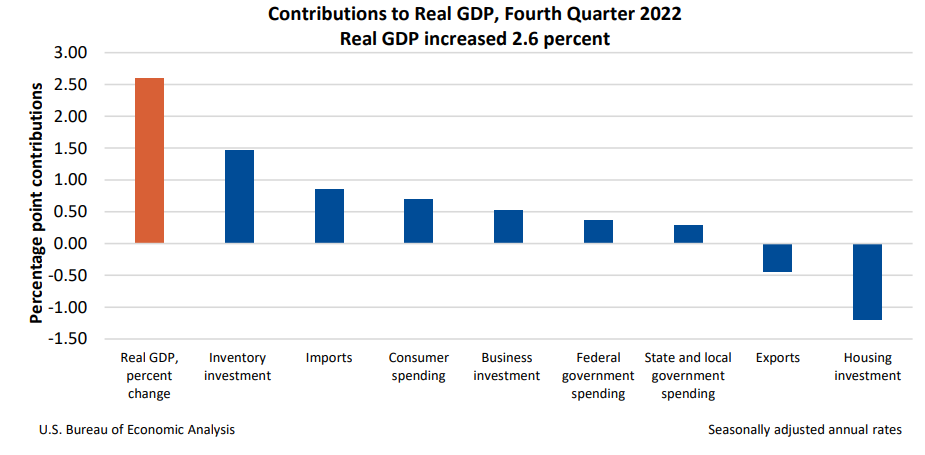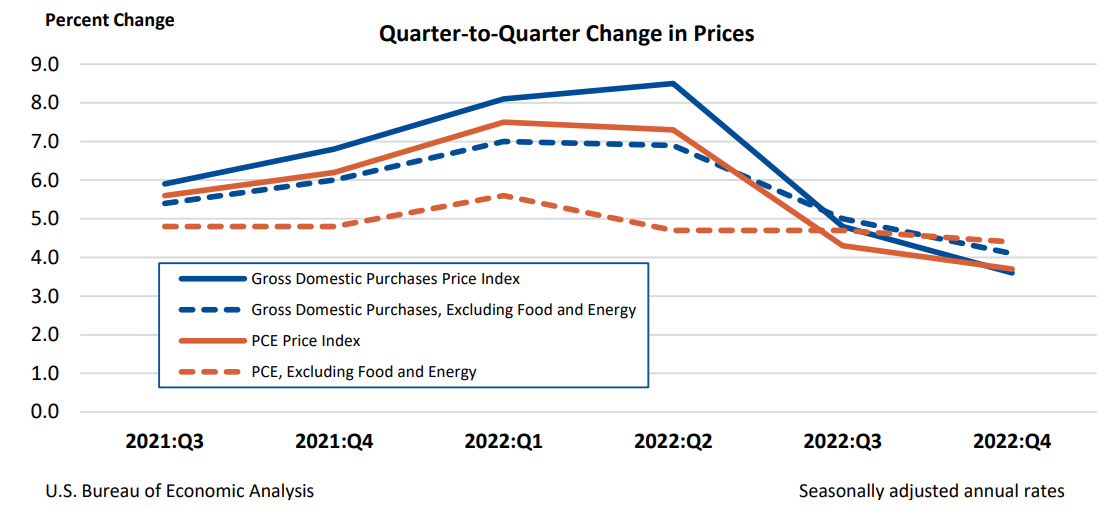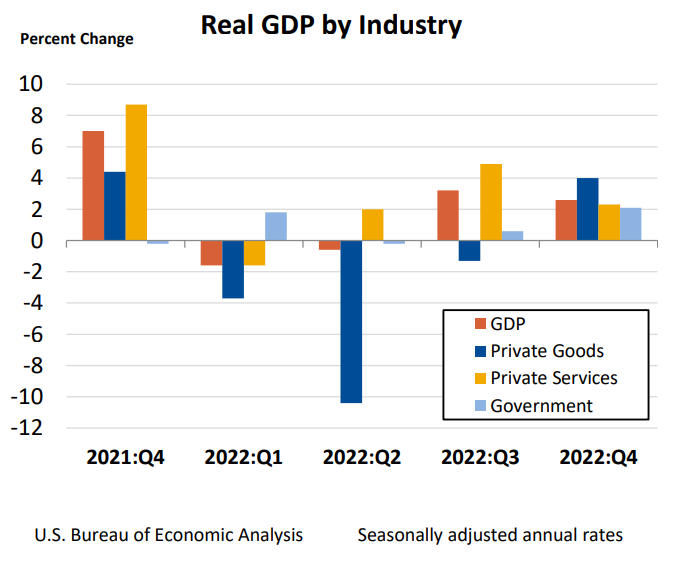Real gross domestic product (GDP) increased at an annual rate of 2.6 percent in the fourth quarter of 2022, after increasing 3.2 percent in the third quarter. The increase in the fourth quarter primarily reflected increases in inventory investment and consumer spending that were partly offset by a decrease in housing investment.
The deceleration in the fourth quarter, compared to the third quarter, primarily reflected a downturn in exports and decelerations in consumer spending, business investment, and state and local government spending. These movements were partly offset by an upturn in inventory investment, a smaller decrease in housing investment, and an acceleration in federal government spending. Imports decreased less in the fourth quarter than in the third quarter. For more details, including source data, refer to the Technical Note.
GDP highlights
The fourth-quarter increase in real GDP reflected increases in inventory investment, consumer spending, business investment, federal government spending, and state and local government spending that were partly offset by decreases in housing investment and exports. Imports, which are a subtraction in the calculation of GDP, decreased.
- The increase in private inventory investment was led by manufacturing (mainly petroleum and coal products) as well as mining, utilities, and construction industries (led by utilities).
- The increase in consumer spending reflected an increase in services (led by health care as well as housing and utilities) that was partly offset by a decrease in goods (led by “other” durable goods, specifically jewelry).
- The decrease in housing investment was led by new single-family housing construction and brokers’ commissions.
Updates to GDP
Real GDP was revised down 0.1 percentage point from the “second” estimate, primarily reflecting downward revisions to exports and consumer spending. The price index for GDP increased 3.9 percent in the fourth quarter, unrevised from the previous estimate.
Personal income and saving
Real disposable personal income (DPI)—personal income adjusted for taxes and inflation— increased 5.0 percent in the fourth quarter after increasing 3.2 percent in the third quarter.
Current-dollar DPI increased 8.9 percent in the fourth quarter, following an increase of 7.7 percent. The increase in current-dollar DPI for the fourth quarter primarily reflected increases in compensation and government social benefits.
Personal saving as a percentage of DPI was 4.0 percent in the fourth quarter, compared with 3.2 percent in the third quarter.
Corporate profits from current production
Profits decreased 2.0 percent in the fourth quarter after decreasing less than 0.1 percent in the third quarter.
- Profits of domestic nonfinancial corporations decreased 1.1 percent after increasing 0.8 percent.
- Profits of domestic financial corporations decreased 12.8 percent after decreasing 0.4 percent.
- Profits from the rest of the world increased 4.8 percent after decreasing 3.4 percent.
Corporate profits increased 2.6 percent in the fourth quarter from one year ago.
Prices
Gross domestic purchases prices, the prices of goods and services purchased by U.S. residents, increased 3.6 percent in the fourth quarter after increasing 4.8 percent in the third quarter. Excluding food and energy, prices increased 4.1 percent after increasing 5.0 percent.
Personal consumption expenditure (PCE) prices increased 3.7 percent in the fourth quarter after increasing 4.3 percent. Excluding food and energy, the PCE “core” price index increased 4.4 percent after increasing 4.7 percent.
Gross domestic product by industry
Today’s release includes estimates of GDP by industry, or value added—a measure of an industry’s contribution to GDP. Private goods-producing industries increased 4.0 percent, private services-producing industries increased 2.3 percent, and government increased 2.1 percent. Overall, 17 of 22 industry groups contributed to the fourth-quarter increase in real GDP.
- Within private goods-producing industries, the increase was led by durable goods manufacturing and mining. Partly offsetting these increases was a decrease in construction.
- Within private services-producing industries, the leading contributors to the increase were professional, scientific, and technical services; retail trade; health care and social assistance; and information. Notable offsets include decreases in finance and insurance as well as real estate and rental and leasing.
- The increase in government reflected increases in both federal government as well as state and local government.
Year 2022 highlights
Real GDP increased 2.1 percent (from the 2021 annual level to the 2022 annual level), compared to an increase of 5.9 percent in 2021. The increase primarily reflected increases in consumer spending, exports, and inventory investment that were partly offset by a decrease in housing investment.
Year 2022 Corporate Profits from Current Production
Profits increased 6.6 percent (from the 2021 annual level to the 2022 annual level) after increasing 22.6 percent in 2021.
- Profits of domestic financial corporations decreased 10.1 percent after increasing 15.6 percent.
- Profits of domestic nonfinancial corporations increased 10.4 percent after increasing 33.1 percent.
- Profits from the rest of the world increased 10.0 percent after decreasing 4.0 percent.
Year 2022 GDP by Industry
Today’s release includes annual estimates of GDP by industry (from the 2021 annual level to the 2022 annual level). Private goods-producing industries decreased 2.8 percent, private services-producing industries increased 3.4 percent, and government increased 1.3 percent. Overall, 15 of 22 industry groups contributed to the 2022 increase in real GDP.
- Within private goods-producing industries the leading contributor to the decrease was construction.
- Within private services-producing industries, an increase in professional, scientific, and technical services was partly offset by a decrease in retail trade.
- The increase in government reflected an increase in state and local government.
For more information, read the full release.


